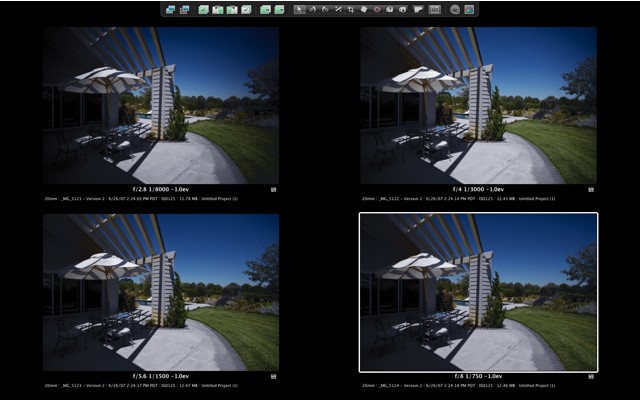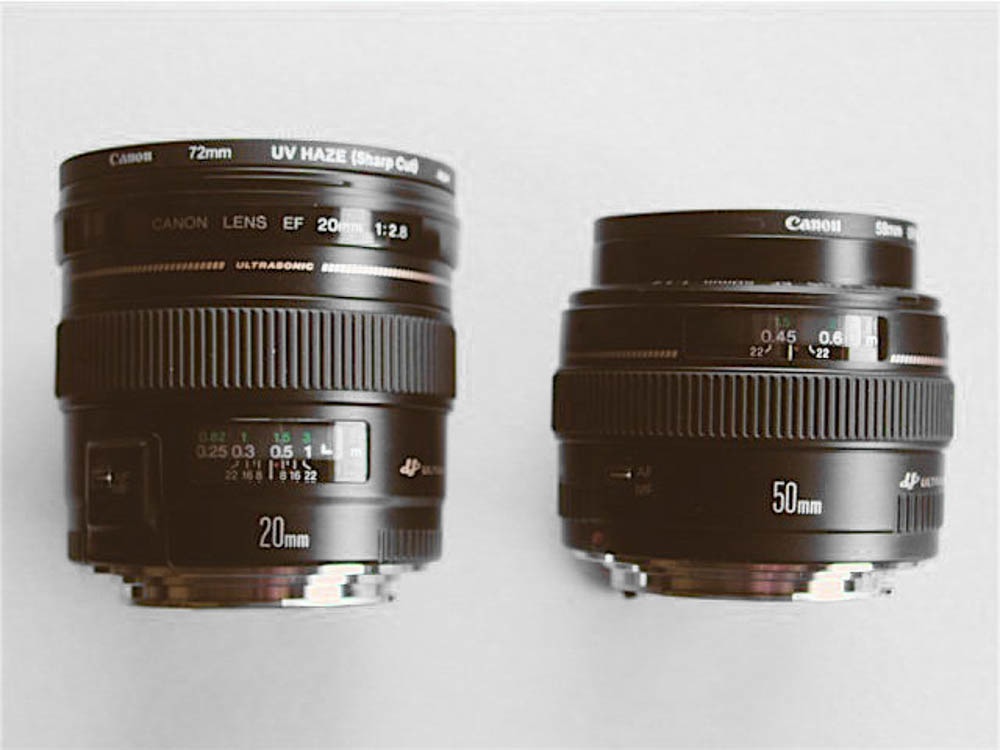Not perfect – you get what you pay for, I suppose.
I wrote in somewhat lukewarm terms of the underwhelming definition of the Canon 20mm lens here.
I took a more objective view of the vignetting issue by banging out four snaps on the old estate, camera and lens dutifully mounted on a tripod, at the four largest apertures:

To best assess vignetting, look at the bottom right corner. The sky is misleading as the changing azimuth angle will provide some natural vignetting with any lens this wide. You can see that at full aperture, f/2.8, the vigneting is pretty awful, but rapidly falls by f/4 with full coverage at f/5.6 and below.
So unless you want to use the Photoshop CS2 Filter->Distort->LensCorrection->Vignette->Amount, (does anyone at Adobe have the remotest iota of common sense when it comes to designing menus – who would guess it’s under ‘Distort’?) f/2.8 is simply not useable. Realistically, if it’s a low light situation, vignetting is no big deal and tends to enhance the drama of a picture. But if you want full coverage to the corners, forget it. Regard the maximum aperture as useful for focusing only.
How about definition? Well, I concluded that my first sample was just not good enough, especially after nothing but great experiences with the 15mm fisheye, the 85mm f/1.8, the 200mm f/2.8 and the 24-105mm zoom. If I can get way better definition from the fisheye after doing all that pixel stretching with ImageAlign (making the lens like a 12mm rectilinear hyper-wide) then all cannot be right with my 20mm sample which clearly has poorer definition than the fisheye. So I bit the bullet and returned the lens to B&H. Moses, of that estimable store, didn’t understand when I explained the lens sucked, but when I pulled Schlecht on him he cottoned on and was very good about it. I had a replacement (with an older serial number, strangely) in my hands in seven business days. Thank you, B&H. Was the result a quantum leap in definition? No. However, overall the ‘bite’ of the image is improved, if still not up to any of the other lenses which, frankly, easily surpass it in this regard. Vignetting in both samples at full aperture is just awful.
The right answer, I suppose, is to get a used Leica 21mm Super Angulon R and adapt it to the 5D. That lens may only be f/4 but it’s fabulous, like all Leica glass. I used one on my Leicaflex SL for years. Unfortunately, the sheer bulk of the lens, compounded by a heavy brass mount and a huge front element, not to mention a complete lack of focus or aperture and exposure automation on the 5D, rules it out. The M Elmarit will not, of course, achieve infinity focus owing to the need for a short flange-to-sensor distance mandated by the rangefinder design. Plus, it’s way overpriced.
So mediocre definition would seem to be the Achilles Heel of this optic – that or I have been an unlucky victim of poor quality control. Canon has little incentive for improving the lens, with everyone being sold on bulky, slow zooms. Shame. Still, at f/8 it’s decent and it’s dirt cheap, too, at $400. If it was much more I would return it.
You can get an idea of the relative size of the 20mm in this picture where it is side by side with the 50mm f/1.4 – it’s not too bulky.

Notice that the 72mm Canon UV filter on the 20mm lens says ‘Sharp Cut’, implying a sharp cut off prior to the infra red range of the spectrum. By contrast the 58mm filter on the 50mm lens bears no such designation. This is rather mystifying (the 77mm filter for the 24-105mm is also ‘Sharp Cut’) as the sensor in the 5D (and probably in their other DSLR offferings) has a built in IR filter – something Leica should have learned before mistakenly releasing the M8 with no IR sensor filter, only to have to issue free lens filters to all buyers as IR rays wreaked havoc with color accuracy. No biggie – Canon’s filters are inexpensive and do the job of protecting my lens’ front elements.
Update: I ended up selling the lens – too much bulk for too little performance. Read all about it here.